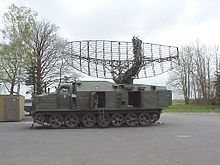AT-T
| AT-T | |
|---|---|

An AT-T from former NVA stocks (2011) |
|
| General properties | |
| crew | 4 + 16 |
| length | 7043 mm |
| width | 3170 mm |
| height | 3000 mm |
| Dimensions | 20.0 tons |
| agility | |
| drive | V12 diesel engine W-401 415 PS (305 kW) |
| suspension | Torsion bar suspension |
| Top speed | 35.5 km / h |
| Power / weight | |
| Range | 1100 km (road) |
AT-T is the name of an all-terrain, unarmored, non-floatable caterpillar vehicle developed in the Soviet Union . AT-T stands for Russian артиллерийский тягач - тяжёлый (artillery traction means - heavy). Internally, the vehicle was also referred to as product 401 (изделие 401). The AT-T was the first caterpillar vehicle developed in the Soviet Union after the end of World War II .
development
At the end of the 1940s there was a need in the Soviet Army , but also in the Soviet economy, for a high-performance, all-terrain towing vehicle. In the military field, this was mainly caused by the increase in the caliber of the artillery, which led to increasingly heavy artillery. But also the very heavy and bulky electronic systems at that time, such as radar stations and guidance systems, required more powerful towing and carrier vehicles. In the civil sector, the demand developed due to the economic development of sparsely populated and largely impassable areas in the east of the country. The AT-T was developed from the mid-1940s in the Kharkov Malyshev factory under the direction of the well-known designer Alexander Alexandrowitsch Morosow . The target was a traction device for a trailer load of up to 25,000 kg. In order to achieve the required off-road mobility, a caterpillar vehicle was developed. Production started in 1947 and continued until 1974. The successor to this was the MT-T , which was based on the chassis of the T-64 battle tank .
construction
The chassis and the propulsion system were taken over from the T-54 battle tank , but the hull was rotated. The engine, clutch, gearbox, steering gear and drive wheels are now in the front of the vehicle, the guide wheels of the drive in the rear. The cabin for the crew is also located in the front part of the vehicle. The cab of the ZIS-150 or ZIL-164 truck was used for the construction . The original cab was widened. It now offered space for four crew members. The cooling system, air filter and ancillary units are located under the original bonnet, the 12-cylinder diesel engine W-401 (a reduced-power variant of the W-2 ) is located below in the tub. The roller drive consists of five rubber-tyred twin rollers. The suspension takes place via torsion bars. The metal platform behind the driver's cab with a load capacity of 5,000 kg offers space for 16 more soldiers.
With the 500 mm wide tracks, a maximum specific ground pressure of 0.652 kg / cm 2 is achieved. The gradeability is a maximum of 40 °, the ground clearance is 425 mm. The vehicle can cross trenches up to 1.8 m wide and, without preparation, drive through bodies of water up to 1.1 m deep.
variants
The AT-T in the version with a flatbed and tarpaulin was used as a traction device for heavy artillery pieces . In addition, the construction served as a base vehicle for various systems. These include u. a .:
- the pioneering machine BAT or BAT-M ,
- the pioneering machine MDK (МДК-2),
- the trench excavator BTM (БТМ).
For the radio station 1S12 ( 1С12 ) was prepared from the product 401 , the product 426 developed. It can be distinguished from the original sample by the additional pair of rollers.
The AT-T also formed the basis for the Kharkovchanka (Харьковчанка), a vehicle specially developed for use in the Antarctic . The vehicle, which is equipped with an additional pair of rollers, has a more powerful engine with 995 hp (732 kW). Crew, equipment and passengers or cargo can be accommodated in a closed, continuous all-metal structure with a volume of 50 m³. Depending on the purpose, there are sleeping places for eight people, a toilet and a galley in the structure.
There are currently some vehicles in the Russian armed forces' inventory. The vehicle is also still used in the civil sector.
See also
Individual evidence
- ↑ Тягачебудування ("МТ-Т")
- ↑ Dozer BAT. (No longer available online.) Archived from the original on March 29, 2008 ; accessed on December 14, 2013 (technical data sheet).
- ↑ Антарктические вездеходы: США vs СССР on ВОЙНА и МИР
- ↑ Тяжелый артиллерийский тягач АТ-Т
Web links
- Артиллерийский тягач АТ-Т on Харьковское Конструкторское Бюро по Машиностроению имени А.А.Морозова (Russian)
- Тяжелый артиллерийский тягач АТ-Т in Основные Средства №9 / 2006 (Russian)
- DV-17/5 vehicle types of the National People's Army, edition 1963, chain tractor AT-T
- Антарктические вездеходы: США vs СССР in ВОЙНА и МИР (Russian)


